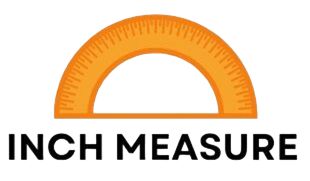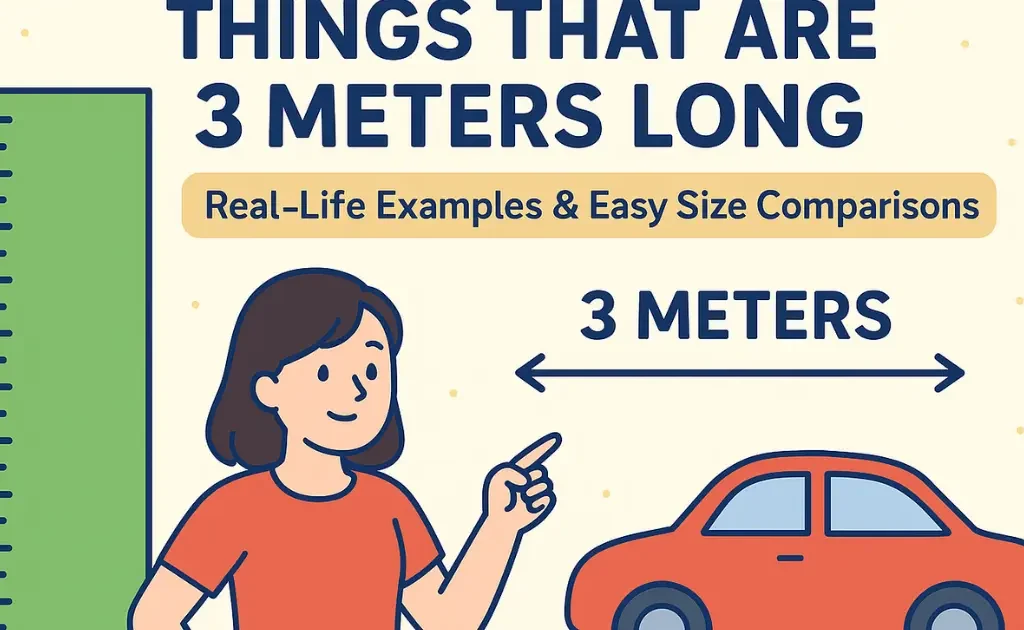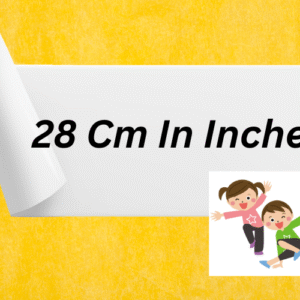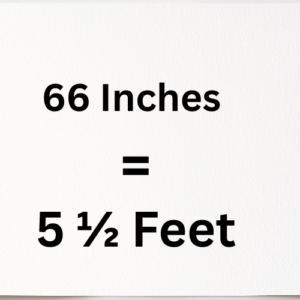Have you ever tried to imagine how long is 3 meters without using a ruler? It can be tricky at first, but once you picture it, 3 meters becomes an easy and useful length to understand. It’s a size that shows up all around us — in cars, rooms, and even garden spaces.
Simply put, 3 meters equals about 9 feet 10 inches. That’s roughly the height of a room or the length of a big dining table. So, when you think about how long is 3 m, you’re really thinking about a length you see and use every day — just without realizing it.
In this simple and clear guide, we’ll help you visualize 3 meters through real-life examples, easy comparisons, and helpful charts. By the end, you’ll not only know exactly how long 3 meters is, but you’ll also be able to spot it around you without even measuring.
What Is a Meter?

The meter is the fundamental unit of length in the metric system, a system adopted by most countries for its decimal-based structure. Defined by the International System of Units (SI), one meter is the distance light travels in a vacuum in 1/299,792,458 seconds. This precise definition, established in 1983, replaced earlier standards based on physical objects, like the platinum-iridium meter bar kept in Paris.
Three meters, therefore, is three times this distance. To visualize, imagine a straight line stretching from the floor to the ceiling of a typical room, as standard ceiling heights in many homes are around 2.4 to 3 meters. This length is neither too short nor excessively long, making it a common dimension in everyday life, from furniture to vehicles to natural objects.
Read Also: How Big Is 2 Inches? 12 Everyday Items to Help You Visualize It
Converting 3 Meters to Other Units
To understand 3 meters in different contexts, let’s convert it to other units of measurement commonly used around the world:
- Feet and Inches (Imperial System): 1 meter equals approximately 3.28084 feet. Therefore, 3 meters is:
- 3 × 3.28084 = 9.84252 feet
- In feet and inches: 9 feet, 10.11 inches (since 0.84252 feet × 12 inches/foot ≈ 10.11 inches)
- Yards: Since 1 yard equals 3 feet, 3 meters is:
- 9.84252 feet ÷ 3 = 3.28084 yards
- Centimeters: 1 meter equals 100 centimeters, so 3 meters is:
- 3 × 100 = 300 centimeters
- Millimeters: 1 meter equals 1,000 millimeters, so 3 meters is:
- 3 × 1,000 = 3,000 millimeters
- Kilometers: 1 kilometer equals 1,000 meters, so 3 meters is:
- 3 ÷ 1,000 = 0.003 kilometers
- Miles: 1 mile equals approximately 1,609.34 meters, so 3 meters is:
- 3 ÷ 1,609.34 = 0.001864 miles
Here’s a table summarizing these conversions:
| Unit | Equivalent to 3 Meters |
| Feet | 9.84252 feet |
| Inches | 118.11 inches |
| Yards | 3.28084 yards |
| Centimeters | 300 centimeters |
| Millimeters | 3,000 millimeters |
| Kilometers | 0.003 kilometers |
| Miles | 0.001864 miles |
This table helps contextualize 3 meters across different measurement systems, especially for those more familiar with imperial units, like in the United States.
Why 3 Meters Matters
Three meters is a practical length in many scenarios. It’s roughly the height of a single-story building’s interior, the length of a mid-sized car, or the span of a large dining table. It’s a measurement that appears frequently in architecture, design, sports, and everyday life. Understanding its scale helps us navigate spaces, estimate distances, and make informed decisions about objects we interact with daily.
For example, in urban planning, 3 meters might represent the width of a sidewalk, ensuring accessibility for pedestrians. In sports, it could be the length of a long jump or the height of a basketball hoop (approximately 3.05 meters). In nature, it might be the length of a small tree or the wingspan of a large bird. By exploring objects that are approximately 3 meters long, we can better appreciate this measurement’s relevance.
Historical Context of the Meter
The meter’s history adds depth to our understanding of 3 meters. Conceived during the French Revolution in the late 18th century, the metric system aimed to standardize measurements globally. The meter was initially defined as one ten-millionth of the distance from the Earth’s equator to the North Pole along a meridian through Paris. This geodetic definition was later refined with more precise standards, leading to the modern light-based definition.
The adoption of the metric system varied globally. While most countries embraced it, the United States retained the imperial system for many applications, leading to the need for conversions like those above. Understanding this history underscores why 3 meters is a universally recognized length in science, engineering, and daily life in metric-using countries.
Visualizing 3 Meters in Everyday Life
To make 3 meters tangible, let’s consider some relatable comparisons:
- Human Height: The average adult male height in many countries is around 1.7–1.8 meters. Stacking two people of average height would slightly exceed 3 meters.
- Car Length: A compact car, like a Toyota Corolla, is about 4.6 meters long, so 3 meters is roughly two-thirds of its length.
- Room Dimensions: In a typical home, a bedroom might be 3 meters wide or long, making it a familiar dimension for interior spaces.
These comparisons help ground the abstract concept of “3 meters” in familiar contexts. Now, let’s explore 16 everyday items that are approximately 3 meters long, each with detailed descriptions to illustrate their relevance.
16 Everyday Items That Are 3 Meters Long
Below, we explore 16 objects commonly found in daily life that measure approximately 3 meters in length. Each section provides context, dimensions, and practical insights to help visualize this measurement.
1. Standard Parking Space

A standard parking space in many countries is approximately 3 meters wide (and about 5–6 meters long). This width accommodates most passenger vehicles, allowing enough room for doors to open and passengers to exit comfortably. In urban areas, parallel parking spaces are often designed with this width to optimize space along streets. For example, in the United States, a typical parking space is about 9–10 feet wide (2.7–3 meters), aligning closely with our target length.
The 3-meter width ensures accessibility, including for individuals using wheelchairs, as it provides sufficient space for ramps or lifts. Visualizing a parking space helps contextualize 3 meters as a practical dimension in urban planning and daily commuting. Next time you park your car, imagine the width of the space as a perfect representation of 3 meters, bridging the gap between abstract measurement and real-world application.
2. Large Dining Table

A large dining table designed for 8–10 people is often around 3 meters long. These tables are common in formal dining rooms or banquet settings, providing ample space for place settings, centerpieces, and communal dining. For instance, a rectangular table measuring 300 cm (3 meters) by 100 cm can seat four people per side with room for two at the ends.
Such tables are crafted from materials like wood, glass, or metal, and their length makes them ideal for hosting large gatherings, such as family holidays or corporate events. The 3-meter length allows for comfortable seating arrangements, ensuring guests aren’t cramped. If you’ve ever dined at a long table during a festive occasion, you’ve experienced this length firsthand, making it a relatable example of 3 meters in domestic settings.
3. Standard Canoe

A standard recreational canoe is typically around 3 meters long (approximately 10 feet). Canoes of this size are popular for solo or tandem paddling on lakes and calm rivers. For example, a lightweight aluminum or fiberglass canoe might measure 3–3.5 meters, offering stability and maneuverability for beginners.
The 3-meter length strikes a balance between portability and functionality, allowing paddlers to navigate tight waterways while carrying gear. In outdoor recreation, this length is ideal for day trips, as it provides enough space for one or two people plus supplies without being unwieldy. Picture a canoe gliding across a serene lake, and you’ve got a perfect mental image of 3 meters in action.
4. Garden Hose Section

A standard garden hose, when laid out straight, often comes in segments of 3 meters or longer. A 3-meter section is a common length for connecting to outdoor faucets or extending watering systems in small to medium-sized gardens. These hoses, typically made of vinyl or rubber, are flexible yet sturdy, with a diameter of about 1.5–2 cm.
This length is practical for reaching flower beds, vegetable patches, or lawn areas without excessive coiling. For gardeners, visualizing a 3-meter hose stretched across a backyard provides a tangible sense of this measurement, especially when watering plants or cleaning outdoor surfaces. It’s a ubiquitous tool that embodies 3 meters in everyday outdoor tasks.
5. Yoga Mat (Three Stacked)

A standard yoga mat is about 1 meter long (typically 68–72 inches, or 1.73–1.83 meters). Stacking three yoga mats end-to-end would approximate 3 meters. Yoga mats are used for exercise, meditation, and stretching, and their portable size makes them a familiar item in fitness routines.
Imagining three yoga mats laid out in a row helps visualize 3 meters in a fitness context. This length could represent the space needed for a small group exercise session or a personal workout area in a gym. The tactile familiarity of yoga mats makes this a relatable way to conceptualize 3 meters for health-conscious individuals.
6. Small Sailboat

A small sailboat, such as a dinghy or a Sunfish, is often around 3 meters long. These boats are designed for one or two sailors and are popular for recreational sailing or beginner training. For example, a Laser Pico sailboat measures approximately 3.5 meters, but smaller models can be closer to 3 meters.
The 3-meter length allows for easy handling and transport, often fitting on a car roof rack. These boats are used in coastal waters, lakes, or sailing schools, offering a compact yet functional platform for learning to sail. Visualizing a small sailboat bobbing on the water provides a dynamic example of 3 meters in the world of water sports.
7. Standard Ladder

A standard household ladder, when collapsed, is often around 3 meters long. Extension ladders, used for tasks like cleaning gutters or painting, may extend to 6 meters or more but have a base length of about 3 meters for portability. These ladders are typically made of aluminum or fiberglass for durability and lightweight handling.
The 3-meter length makes them easy to store in a garage or shed while providing sufficient reach for most home maintenance tasks. Picture a ladder leaning against a house or folded for storage, and you’ve got a clear image of 3 meters in a practical, home-improvement context.
8. Large Area Rug

A large area rug, often used in living rooms or dining areas, can measure approximately 3 meters in length (e.g., a 3m x 2m rug). These rugs define spaces in open-plan homes, adding warmth and style. Made from materials like wool, polyester, or cotton, they come in various patterns and textures.
A 3-meter-long rug can anchor a seating area for a sofa and chairs or fit under a dining table for 6–8 people. Visualizing a rug spread across a living room floor helps connect 3 meters to interior design, making it a familiar dimension for homeowners and decorators.
9. Row of Kitchen Countertops

In modern kitchens, a standard countertop section is about 60–80 cm deep and can be around 3 meters long in a straight run. This length accommodates appliances, prep space, and storage, making it a common dimension in home design. Materials like granite, quartz, or laminate are used for durability and aesthetics.
A 3-meter countertop might span the length of a small to medium-sized kitchen, housing a sink, stove, and cutting area. For anyone who cooks or designs kitchens, this length is instantly recognizable, tying 3 meters to culinary and architectural contexts.
10. Standard Surfboard

A standard shortboard surfboard is approximately 3 meters long (about 9–10 feet). These boards are used by intermediate to advanced surfers for maneuverability and performance. Made from foam, fiberglass, and epoxy, they’re lightweight yet strong, designed to ride waves effectively.
The 3-meter length allows surfers to balance speed and control, making it ideal for various wave conditions. Picture a surfer carrying a board under their arm or riding a wave, and you’ve captured 3 meters in the context of adventure sports.
11. Large Bookshelf

A large bookshelf, often found in libraries or home offices, can be around 3 meters wide. These units, typically made of wood or metal, hold books, decor, or storage bins, providing ample space for organization. A 3-meter bookshelf might have 4–5 shelves, accommodating hundreds of books.
This length is practical for filling a wall in a study or living room, creating a focal point for literature lovers. Visualizing a bookshelf packed with novels or textbooks brings 3 meters into the realm of education and home organization.
12. Soccer Goal Width

The width of a standard soccer goal for youth or recreational play is approximately 3 meters (though professional goals are 7.32 meters). These smaller goals, used in training or children’s leagues, are made of metal or plastic and feature a net for catching balls.
The 3-meter width challenges young players to aim accurately while allowing goalkeepers a manageable area to defend. For sports enthusiasts, imagining a soccer goal provides a dynamic way to visualize 3 meters in athletic contexts.
13. Large Umbrella

A large patio or beach umbrella, when fully extended, can have a canopy diameter of about 3 meters. These umbrellas provide shade for outdoor dining or lounging, made with materials like polyester or canvas for UV protection. The 3-meter span covers a table for 6–8 people or a small group of beachgoers.
Visualizing an open umbrella over a picnic table or on a sandy shore ties 3 meters to outdoor leisure, making it a relatable example for warm-weather activities.
14. Small Fishing Boat

A small fishing boat, like a jon boat or skiff, is often around 3 meters long. These boats, made of aluminum or fiberglass, are used for angling in calm waters like lakes or rivers. The 3-meter length accommodates one or two anglers with gear, offering stability and portability.
Picture a fisherman casting a line from a compact boat, and you’ve got a clear image of 3 meters in recreational fishing, a context familiar to outdoor enthusiasts.
15. Large Wall Art

A large piece of wall art, such as a canvas painting or tapestry, can measure approximately 3 meters wide. These pieces are used as statement decor in homes, offices, or galleries, often featuring abstract designs, landscapes, or custom graphics. Materials range from canvas to metal to woven fabric.
A 3-meter-wide artwork can dominate a living room wall or serve as a focal point in a corporate lobby. For art lovers, this dimension connects 3 meters to aesthetics and interior design.
16. Standard Clothesline

A standard outdoor clothesline, when stretched taut, is often around 3 meters long. Used for air-drying laundry, these lines are made of rope, wire, or nylon and are common in households without dryers. The 3-meter length can hold a full load of laundry, like sheets or clothing.
Visualizing a clothesline strung across a backyard, laden with towels or shirts, ties 3 meters to sustainable living and household chores, a practical example for many.
Practical Applications of 3 Meters
Beyond everyday objects, 3 meters appears in various fields:
- Architecture: Ceiling heights, door widths, or room dimensions often hover around 3 meters for ergonomic design.
- Sports: From pole vault heights to diving board lengths, 3 meters is a common benchmark.
- Nature: Small trees, like young maples or pines, can reach 3 meters, as can the wingspan of large birds like albatrosses.
- Transportation: Bicycle lanes or small trailers often measure around 3 meters in width or length.
Here’s a table summarizing some applications:
| Field | Example | Approximate Length |
| Architecture | Ceiling height | 2.4–3 meters |
| Sports | Youth soccer goal width | 3 meters |
| Nature | Young tree height | 3 meters |
| Transportation | Bicycle lane width | 3 meters |
Challenges in Estimating 3 Meters
Estimating 3 meters by eye can be tricky, especially without reference objects. Human perception of distance varies based on context, lighting, and experience. For instance, 3 meters in an open field may seem shorter than 3 meters in a cramped room due to visual cues. Using familiar objects, like those listed above, helps train the eye to recognize this length.
Cultural Perspectives on Measurement
Different cultures perceive and use measurements like 3 meters uniquely. In metric-using countries, 3 meters is a standard reference, while in imperial-using regions, people might think in terms of 10 feet. This dichotomy affects design, construction, and even daily conversations. Understanding these perspectives fosters better communication in globalized settings.
You May Also Need To Know: how long is 7 inches
Conclusion
Now you know exactly how long is 3 meters! It’s about the height of a room, the width of a small car, or three big steps for most adults. Pretty easy to picture, right?
Understanding 3 meters helps in so many little ways — when you plan a room, measure a wall, or guess how big something really is. Next time you wonder about any length, you can check it quickly with our online measurement converter tools to see the size in inches, feet, or centimeters.
So, whether you’re building, decorating, or just curious, remembering what 3 meters looks like will always be helpful.
Convert Inches to Meters, cm, mm, and Feet
Converted Values:
Meters (m): 1.016
Centimeters (cm): 101.60
Millimeters (mm): 1016.00
Feet (ft): 3.33





